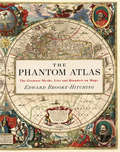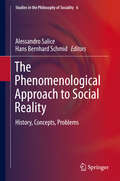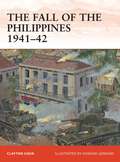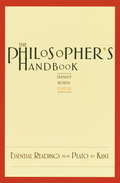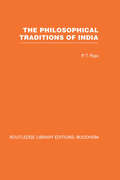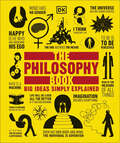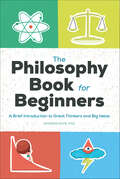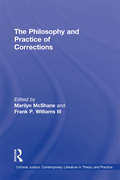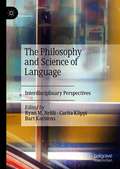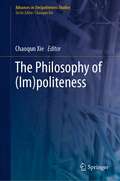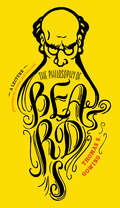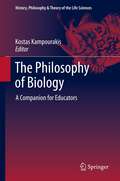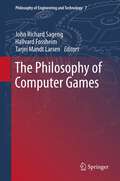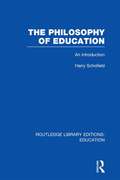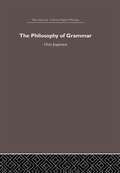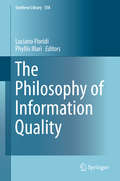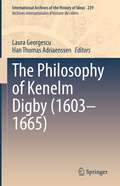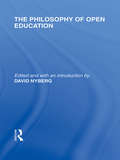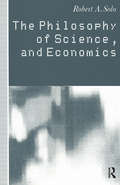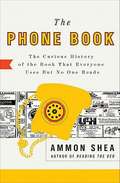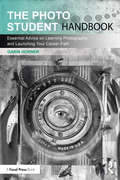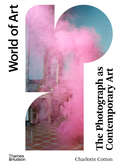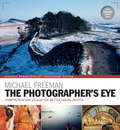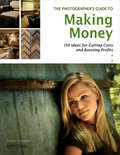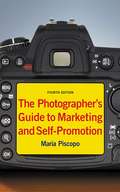- Table View
- List View
The Phantom Atlas: The Greatest Myths, Lies And Blunders On Maps
by Edward Brooke-HitchingThe Phantom Atlas is a guide to the world not as it is, but as it was imagined to be. It's a world of ghost islands, invisible mountain ranges, mythical civilizations, ship-wrecking beasts, and other fictitious features introduced on maps and atlases through mistakes, misunderstanding, fantasies, and outright lies. This richly illustrated book collects and explores the colorful histories behind a striking range of real antique maps that are all in some way a little too good to be true. Author Edward Brooke-Hitching investigates the places where exploration and mythology meet, using gorgeous atlas images as springboards for tales of the deranged buccaneers, seafaring monks, heroes, swindlers, and other amazing stories behind cartography's greatest phantoms.
The Phenomenological Approach to Social Reality: History, Concepts, Problems (Studies in the Philosophy of Sociality #6)
by Hans Bernhard Schmid Alessandro SaliceThis volume features fourteen essays that examine the works of key figures within the phenomenological movement in a clear and accessible way. It presents the fertile, groundbreaking, and unique aspects of phenomenological theorizing against the background of contemporary debate about social ontology and collective intentionality.The expert contributors explore the insights of such thinkers as Martin Heidegger, Edmund Husserl, Adolf Reinach, and Max Scheler. Readers will also learn about other sources that, although almost wholly neglected by historians of philosophy, testify to the vitality of the phenomenological tradition. In addition, the contributions highlight the systematic relevance of phenomenological research by pinpointing its position on social ontology and collective intentionality within the history of philosophy.By presenting phenomenological contributions in a scholarly yet accessible way, this volume introduces an interesting and important perspective into contemporary debate insofar as it bridges the gap between the analytical and the continental traditions in social philosophy. The volume provides readers with a deep understanding into such questions as: What does it mean to share experiences with others? What does it mean to share emotions with friends or to share intentions with partners in a joint endeavor? What are groups? What are institutional facts like money, universities, and cocktail parties? What are values and what role do values play in social reality?
The Philippines 1941-42
by Howard Gerrard Clayton ChunThe Philippine Islands were one of two major US bases in the Pacific, the other being Pearl Harbor. The Japanese considered the capture of the Philippines crucial for its efforts to control resource-laden Southeast Asia. As opposed to its attack on Pearl Harbor, the Japanese intention was to invade and occupy the Philippines in a campaign that was to last five months. The flamboyant Douglas MacArthur, a hero of World War I and former Chief of Staff led the defense of the Philippines when the Japanese attacked on 8 December 1941. Despite warnings about the Pearl Harbor attack, the Japanese air forces caught MacArthur's aircraft on the ground resulting in half of his modern bomber and fighter aircraft destroyed. Army Air Forces B-17s attempted to bomb Formosa, but Japanese fighters eliminated them and a Japanese full-scale invasion followed days later.Japanese forces landed in northern Luzon from Formosa. B-17s and naval attacks tried in vain to stop the invasion, but failed. Poorly trained and equipped Philippine Army units could not halt the Japanese and the American and Filipino forces withdrew, even though they outnumbered the initial Japanese forces. Japanese Army units broke through several defensive lines as they drove on to Manila, which was abandoned by the Americans as Macarthur withdrew to Bataan. The Japanese gradually reduced this pocket until the only American position was Corregidor Island. MacArthur left for Australia, as a direct order from President Franklin Roosevelt and was awarded the Medal of Honor, one of the more controversial aspects of the campaign. With little hope of survival, Corregidor fell, with organized resistance ending on 9 May 1942.Although a defeat, the American and Filipino defensive efforts upset the Japanese plan for a swift victory and provided time for Australia and the United States to build up their defenses. It also gave hope to the American public that Americans could stand up to Japan, with the "Battling Bastards of Bataan" providing a source of inspiration. Unfortunately, for the survivors of the campaign, it meant a grueling three years of captivity for some. The Bataan Death March was one of the most infamous events in World War II, with Japanese forces responsible for the deaths of about 600 Americans and between 5,000-10,000 Filipino soldiers dying in the march, some summarily executed by beheading.
The Philosopher's Handbook: Essential Readings from Plato to Kant
by Stanley RosenAn ideal introduction for the casual reader and a beneficial reference for the student,The Philosopher's Handbookfeatures the writings of some of the world's most influential philosophers. Based on the premise that all human beings are curious about their existence, Rosen's collection brings together primary excerpts from the works of prominent thinkers such as Plato, Nietzsche, Descartes, Machiavelli, and Kant. Experts in each field have carefully selected the sources and provided brief introductions to help readers gain insight into the readings. Newly revised in order to emphasize its broad appeal,The Philosopher's Handbookis a solid introduction to Western philosophy for all inquiring minds.
The Philosophical Traditions of India (Routledge Library Editions: Buddhism)
by P T RajuThis volume conveys that Indian philosophy has intricate and complex metaphysical and epistemological theories as other philosophies and that these disciplines – epistemology and metaphysics – are an essential part of Indian philosophy.
The Philosophy Book (DK Big Ideas)
by DKGet to grips with the concepts that shaped the way we think about ethics, politics, and our place in the universe.Explaining the big ideas and groundbreaking theories of key philosophers clearly and simply, The Philosophy Book is the perfect one-stop guide to philosophy and the history of how we think. Untangling knotty theories and shedding light on abstract concepts, entries explore and explain each complex idea with easy-to-follow explanations and innovative visuals. Explore the history of philosophy, from ancient Greece and China to today, and find out how theories from over 2,000 years ago are still relevant to our modern lives. Follow the progression of human ideas and meet the world's most influential philosophers – from Plato and Confucius through René Descartes and Mary Wollstonecraft to Ludwig Wittgenstein and Judith Butler.Dive into this phenomenal philosophy book to discover:-An accessible guide to philosophy, covering every major school and movement throughout history.-The clear and detailed text explains the most groundbreaking philosophical concepts and theories ever devised, while bold illustrations and pull-out quotes bring each idea to life.-Fully revised and updated to cover any developments in the field over the last 5–10 years.-Biography and context boxes place each idea in its wider historical, cultural, and social context.Your Philosophical Questions, Simply ExplainedIf you thought it was difficult to learn philosophy and its many concepts, The Philosophy Book presents the key ideas in a clear layout. Find out what philosophers thought about the nature of reality and the fundamental questions we ask ourselves: What is the meaning of life? What is the Universe made of? And work your way through the different branches of philosophy, such as metaphysics and ethics, from ancient and modern thinkers.The Big Ideas SeriesWith millions of copies sold worldwide, The Philosophy Book is part of the award-winning Big Ideas series from DK. The series uses striking visuals and engaging writing, making big topics easy to understand.
The Philosophy Book for Beginners: A Brief Introduction to Great Thinkers and Big Ideas
by Sharon KayeExplore big questions and understand complex philosophyWho are you? What is truly real? Is there such a thing as free will? If you have ever considered questions like these, that's philosophy. The Philosophy Book for Beginners breaks down the core concepts of both Eastern and Western philosophy in clear language that explains the most important people and ideas. You'll develop an understanding of the basic ideas and see your understanding of the world expand—no dense, academic texts required.The major branches—Explore the central questions of metaphysics, epistemology, logic, and axiology as you see how they changed over time.A wide range of thinkers—Discover the diverse perspectives of philosophers, from Socrates in the fifth century BCE to modern-day thinkers like Martha Nussbaum.Thought experiments—Each chapter focuses on a topic, like existentialism, stoicism, or radical faith, and ends with a related thought experiment for you to ponder.Gain a solid understanding of philosophy, with a book that makes it easy to grasp and relevant to the world today.
The Philosophy and Practice of Corrections (Criminal Justice: Contemporary Literature in Theory and Practice #4)
by Frank P. Williams III Marilyn McShanePublished in 1997, The Philosophy and Practice of Corrections is a valuable contribution to the field of Sociology & Social Policy.
The Philosophy and Science of Language: Interdisciplinary Perspectives
by Ryan M. Nefdt Carita Klippi Bart KarstensThis volume brings together a diverse range of scholars to address important philosophical and interdisciplinary questions in the study of language. Linguistics throughout history has been a conduit to the study of the mind, brain, societal structure, literature and history itself. The epistemic and methodological transfer between the sciences and humanities in regards to linguistics has often been documented, but the underlying philosophical issues have not always been adequately addressed. With 15 original and interdisciplinary chapters, this volume therefore tackles vital questions relating to the philosophy, history, and theoretical interplay between the study of language and fields as varied as logic, physics, biology, classical philology and neuroscience. With a four part structure, questions of the mathematical foundations of linguistics, links to the natural sciences, cognitive implications and historical connections, take centre stage throughout the volume. The final chapters present research related to the linguistic connections between history, philosophy and the humanities more broadly. Advancing new avenues of research, this volume is exemplary in its treatment of diachronic and cross-disciplinary interaction, and will be of interest to all scholars interested in the study of language.
The Philosophy of (Advances in (Im)politeness Studies)
by Chaoqun XieThis book explores what new light philosophical approaches shed on a deeper understanding of (im)politeness. There have been numerous studies on linguistic (im)politeness, however, little attention has been paid to its philosophical underpinnings. This book opens new avenues for both (im)politeness and philosophy. It contributes to a fruitful dialogue among philosophy, pragmatics, and sociology. This volume appeals to students and researchers in these fields.
The Philosophy of Beards: A Lecture: Physiological, Artistic & Historical
by Thomas S. GowingA humorous and bizarre artifact from the Victorian culture of manliness, and the perfect gift book for the man in your life -- bearded or not.The Philosophy of Beards is a curious look into the Victorian culture of hyper-manliness. The author makes his case for the universal wearing of a beard--proclaiming that a beard is the essential symbol of manly virtue and distinction since time immemorial. The book is here republished for the first time since 1854 in this disctinctive gift edition, edited by the British Library with illustrations of impressive beards from history.
The Philosophy of Biology
by Kostas KampourakisThis book brings together for the first time philosophers of biology to write about some of the most central concepts and issues in their field from the perspective of biology education. The chapters of the book cover a variety of topics ranging from traditional ones, such as biological explanation, biology and religion or biology and ethics, to contemporary ones, such as genomics, systems biology or evolutionary developmental biology. Each of the 30 chapters covers the respective philosophical literature in detail and makes specific suggestions for biology education. The aim of this book is to inform biology educators, undergraduate and graduate students in biology and related fields, students in teacher training programs, and curriculum developers about the current state of discussion on the major topics in the philosophy of biology and its implications for teaching biology. In addition, the book can be valuable to philosophers of biology as an introductory text in undergraduate and graduate courses.
The Philosophy of Computer Games
by Tarjei Mandt Larsen John Richard Sageng Hallvard J FossheimComputer games have become a major cultural and economic force, and a subject of extensive academic interest. Up until now, however, computer games have received relatively little attention from philosophy. Seeking to remedy this, the present collection of newly written papers by philosophers and media researchers addresses a range of philosophical questions related to three issues of crucial importance for understanding the phenomenon of computer games: the nature of gameplay and player experience, the moral evaluability of player and avatar actions, and the reality status of the gaming environment. By doing so, the book aims to establish the philosophy of computer games as an important strand of computer games research, and as a separate field of philosophical inquiry. The book is required reading for anyone with an academic or professional interest in computer games, and will also be of value to readers curious about the philosophical issues raised by contemporary digital culture.
The Philosophy of Education: An Introduction (Routledge Library Editions: Education)
by Harry SchofieldThere are many students who find philosophy of education difficult, because they have never received teaching in the basic essentials of general philosophy. This book begins by asking the basic question ‘what is philosophy?’ and examines a number of possible answers. Step by step the reader is introduced to the modern techniques of linguistic and concept analysis. Whenever a technical term is used it is explained and illustrated by reference to familiar situations in everyday life.
The Philosophy of Information Quality (Synthese Library #358)
by Luciano Floridi Phyllis IllariThis work fulfills the need for a conceptual and technical framework to improve understanding of Information Quality (IQ) and Information Quality standards. The meaning and practical implementation of IQ are addressed, as it is relevant to any field where there is a need to handle data and issues such as accessibility, accuracy, completeness, currency, integrity, reliability, timeliness, usability, the role of metrics and so forth are all a part of Information Quality.In order to support the cross-fertilization of theory and practice, the latest research is presented in this book. The perspectives of experts from beyond the origins of IQ in computer science are included: library and information science practitioners and academics, philosophers of information, of engineering and technology, and of science are all contributors to this volume.The chapters in this volume are based on the work of a collaborative research project involving the Arts and Humanities Research Council and Google and led by Professor Luciano Floridi, University of Oxford.This work will be of interest to anyone handling data, including those from commercial, public, governmental and academic organizations. The expert editors’ contributions introduce issues of interest to scientists, database curators and philosophers, even though the issues may be disguised in the language and examples common to a different discipline.
The Philosophy of Kenelm Digby (International Archives of the History of Ideas Archives internationales d'histoire des idées #239)
by Han Thomas Adriaenssen Laura GeorgescuThis book examines the philosophical and scientific achievements of Sir Kenelm Digby, a successful English diplomat, privateer and natural philosopher of the mid-1600s. Not widely remembered today, Digby is one of the most intriguing figures in the history of early modern philosophers. Among scholars, he is known for his attempt to reconcile what perhaps seem to be irreconcilable philosophical frameworks: Aristotelianism and early modern mechanism.This contributed volume offers the first full-length treatment of Digby’s work and of the unique position he occupied in early modern intellectual history. It explores key aspects of Digby’s metaphysics, epistemology, and philosophical method, and offers a new appraisal of his contributions to early modern natural philosophy and mathematics.A dozen contributors offer their expert insight into such topics asBody, quantity, and measures in Digby's natural philosophyEcumenism and common notions in DigbyAristotelianism and accidents in Digby's philosophyDigby on body and soulDigby on method and experimentsThis book volume will be of benefit to a broad audience of scholars, educators, and students of the history of early modern science and philosophy.
The Philosophy of Open Education (International Library of the Philosophy of Education Volume 15)
by David Nyberg'Open', 'informal', and 'humanistic' are words used to describe new styles of education which depart from ordinary or traditional education. Too often, however, these adjectives are used in a strongly polemical or self-justifying rather than analytical way. Often too, the grounds for accepting or rejecting open education are political or moral, instead of being based on a consideration of the nature of open education and its strength and weaknesses. This collection of essays is central to the debate on open education, analyzing the important concepts in the field. The contributions, all written by authorities on the philosophy of education, deal with problems of definition, knowledge, socialization, freedom, cultural perspective, and unique meanings and metaphors.
The Philosophy of Science and Economics
by Robert A. SoloThe philosophy of science proposes criteria to delineate true science and a theory to explain its progress. As a graduate student under the supervision of Lionel Robbins and Karl Popper, Solo first challenged the viability of those criteria and that theory in relation to economics and the social sciences. Here he explains how the foundations of that philosophy have been eroded through the advent of quantum mechanics and through Kuhn's "Structures of Scientific Revolution", and demonstrates its irrelevance to a social science that would comprehend social reality and contribute to the formation of social policy. He proposes a different mode of perception, and different rules for determining the acceptability of statement, a different language of discourse, and a different structure of organization than presently prevails.
The Phone Book
by Ammon SheaRead Ammon Shea's blogs and other content on the Penguin Community. A surprising, lively, and rich history of that ubiquitous doorstop that most of us take for granted. Ammon Shea is not your typical thirtysomething book enthusiast. After reading the Oxford English Dictionary from cover to cover (and living to write about it in Reading the OED), what classic, familiar, but little-read book would he turn to next? Yes, the phone book. With his signature combination of humor, curiosity, and passion for combing the dustbins of history, Shea offers readers a guided tour into the surprising, strange, and often hilarious history of the humble phone book. From the first printed version in 1878 (it had fifty listings and no numbers) to the phone book's role in presidential elections, Supreme Court rulings, Senate filibusters, abstract art, subversive poetry, circus sideshows, criminal investigations, mental-health diagnoses, and much more, this surprising volume reveals a rich and colorful story that has never been told-until now. .
The Photo Student Handbook: Essential Advice on Learning Photography and Launching Your Career Path
by Garin HornerThe Photo Student Handbook is a collection of short, easy-to-read chapters filled with expert advice on enhancing image-making skills and launching a career as a professional photographer. Designed to help students grow beyond the technical aspects of photography, this book presents a variety of methods and strategies proven to strengthen visual awareness, engage creative thinking, and deepen the conceptual aspects of image-making. Topics include how to: - improve the ability to see actively - understand light as a main character - cultivate a creative mind - make a standout portfolio - unpack critical theory - find and develop a creative voice. Packed with valuable tips, insights, and advice from over a hundred instructors, professionals, senior students, and experts, this book is engineered to help instructors guide students step-by-step through the methods and strategies needed to achieve creative success both in the classroom and the real world. This book is ideal for intermediate- and advanced-level photography students and instructors alike. Visit the accompanying website www.photostudent.net for extra chapters, exercises, quizzes, and more.
The Photograph as Contemporary Art: Third Edition (World of Art #0)
by Charlotte CottonA new edition of the definitive title in the field of contemporary art photography by one of the world’s leading experts on the subject, Charlotte Cotton. In the twenty-first century, photography has come of age as a contemporary art form. Almost two centuries after photographic technology was first invented, the art world has fully embraced it as a legitimate medium, equal in status to painting and sculpture. The Photograph as Contemporary Art introduces the extraordinary range of contemporary art photography, from portraits of intimate life to highly staged directorial spectacles. Arranged thematically, the book reproduces work from a vast span of photographers, including Andreas Gursky, Barbara Kasten, Catherine Opie, Cindy Sherman, Deana Lawson, Diana Markosian, Elle Pérez, Gregory Halpern, Lieko Shiga, Nan Goldin, Paul Mpagi Sepuya, Pixy Liao, Susan Meiselas, and Zanele Muholi. This fully revised and updated new edition revitalizes previous discussion of works from the 2000s through dialogue with more recent practice. Alongside previously featured work, Charlotte Cotton celebrates a new generation of artists who are shaping photography as a culturally significant medium for our current sociopolitical climate. A superb resource, The Photograph as Contemporary Art is a uniquely broad and diverse reflection of the field.
The Photographer's Eye Remastered 10th Anniversary: Composition and Design for Better Digital Photographs (The Photographer's Eye #7)
by Michael FreemanWith a completely refreshed look to celebrate its tenth anniversary, Michael Freeman's iconic bestseller, The Photographer's Eye, has never looked better.Design is the single most important factor in creating a successful photograph. The ability to see the potential for a strong picture and then organize the graphic elements into an effective, compelling composition has always been one of the key skills in making photographs. Of course, digital photography has brought a new, exciting aspect to design first because the instant feedback from a digital camera allows immediate appraisal and improvement; and second because image-editing tools make it possible to alter and enhance the design after the shutter has been pressed. This has had a profound effect on the way digital photographers take pictures. The Photographers Eye shows how anyone can develop an eye for seeing great digital photos. The book explores all the traditional approaches to composition and design, but crucially, it also addresses the new digital technique of shooting in the knowledge that a picture will later be edited, manipulated, or montaged to result in a final image that may be very different from the one seen in the viewfinder.
The Photographer's Guide to Making Money
by Karen DorameThis comprehensive reference guide discusses opening a photography studio from the ground up, what equipment to purchase, how to make the most of marketing, and how to streamline production efforts.
The Photographer's Guide to Marketing and Self-Promotion
by Maria PiscopoThis fourth edition is updated throughout with the best current marketing and promotional practices, including using e-mail, social media, and effective Web sites; what's new in photography portfolios; how to shoot what you want and sell it too; plus 25 in-depth case studies interviewing top photographers in commercial, editorial, wedding, portrait, event, and fine art photography. Promotion pieces, portfolios, researching and winning clients, negotiating rates, finding and working with reps, computers, and the ethics of good business are just a few of the topics covered. Real-life examples, case studies, and interviews, clearly show photographers how to build a satisfying and lucrative career.
